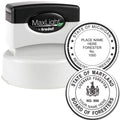Natural light can make a cramped room feel bigger. But what if you need something more precise for your production line or quality checks? If you’re in the market for an inspection stamp with initials, you’ve come to the right place. Selecting the perfect stamp for your professional needs might sound daunting, but it’s simpler than you think. You just need a friendly guide to walk you through it.
In this article, you’ll find clear tips on choosing a custom inspection stamp, from deciding on the right materials to understanding how personalization benefits your workflow. By the end, you’ll feel ready to pick a reliable stamp that reflects your standards. Let’s get started.
Understand The Role Of An Inspection Stamp
An inspection stamp is more than a tiny ink pad with your initials. It’s a convenient way to mark and track product checks, sign off on final approvals, or verify quality control procedures. When you see a neatly stamped set of initials on a product or document, you know someone took the time to ensure it meets the specified criteria.
Why Stamps Matter For Accountability
When it comes to quality management, accountability is essential. Many industries need a clear trail to show which person completed an inspection or performed a check. Stamping your initials not only adds a professional touch, but it also creates a direct link to the individual responsible for verifying those items. If any issues arise later, you can easily trace them back to the relevant process, making problem-solving more effective.
Personalized vs. Generic Stamps
You might be wondering if personalization really matters. After all, a generic stamp that says “Approved” or “Inspected” can still indicate a product has been checked. But adding your unique initials or a custom design ups the game. Personalized inspection stamps help distinguish individual inspectors, allowing managers or auditors to see who handled each step. Plus, including your name or initials can enhance your sense of ownership and pride in the work.
Consider Your Business Needs
Before browsing different types of inspection stamps, it pays to take a moment and think about your daily operations. Do you need a small, lightweight stamp to carry between workstations, or is a sturdy, self-inking stamp more your style? Balancing convenience, durability, and clarity of mark is key.
Common Uses In Quality Checks
- Approving final product shipments
- Marking intermediate steps (e.g. completed sub-assemblies)
- Documenting safety inspections
- Signaling equipment calibrations
If you’re regularly dealing with numerous items, you might lean toward a high-capacity self-inking stamp to save time. In a smaller setting, a simple wooden handle stamp could suffice, especially if you don’t mind reinking it manually. Either way, selecting the right inspection stamp with initials is about matching your workflow.
Matching Industry Regulations
In regulated industries like pharmaceuticals or aerospace, stamp clarity and precision can be an absolute must. Faint impressions may lead to re-dos or even compliance issues, so opt for stamps that produce crisp, readable marks. The format of your initials might also be dictated by guidelines: some regulatory bodies specify whether to use first and last initials, or even require including a certification number. Keeping track of these details up front can help avoid compliance hiccups later.
Explore Essential Stamp Features
Let’s face it, a stamp is only as good as the consistency and clarity of the impression it leaves. If you frequently work in dusty or oily environments, your stamp material and ink type become even more important. Carefully consider the following features when making your selection.
Ink Color And Type Options
Choosing the right ink doesn’t just affect how your stamp looks, it can also determine how fast it dries and whether it’s suitable for specific surfaces. Some common ink color choices include black, blue, red, and green. Certain specialized inks are designed for quick drying on non-porous materials, while others excel on paper. It’s wise to check if your industry or facility requires a particular ink color for QC or QA documentation.
Stamp Materials And Body Styles
Plastic Housing
Lightweight and often cost-effective
Good for occasional use or stationary stamping
Metal Frame
Sturdier and ideal for heavy, frequent stamping
Can withstand accidental drops and rugged work environments
Wood Handle
Classic look and easy to custom brand
Requires a separate ink pad
Weigh the trade-offs between cost and durability. If you stamp hundreds of times a day, a metal-body self-inking model can save you from mid-day malfunctions. On the other hand, if your usage is light, a simpler (and often cheaper) wood-handle style might serve you just fine.
Shape And Layout Considerations
Rectangular stamps work great for text logos or blocky designs, while round stamps might give you a more traditional seal look. Think about which shape complements your initials best. A well-considered layout is easier to read and instantly tells the viewer what the stamp is for. Be sure to leave enough space so your letters or brand elements aren’t cramped.
Why Initials Matter
Personalizing your inspection stamp with initials offers multiple advantages. It creates an instant link to the responsible party, which benefits any quality control traceability system. Imagine a large production run with five or six inspectors. Using individual initials helps keep track of who signed off on each batch or item, reducing confusion and potential finger-pointing.
Adds A Professional Touch
A well-designed stamp hints at professionalism and attention to detail. If you’re in a client-facing role, you might occasionally mark documents or sample items for them to see. Clients who notice your stamp with your initials could get the impression that you’re thorough and committed to accountability. First impressions often matter, and a neat personalized stamp quietly communicates, “I care about the details.”
Sets You Apart
In workplaces where multiple inspectors share tools and equipment, unique initials set your work apart. Rather than rummaging around for whichever stamp is closest, having your own makes you more efficient. It saves time, minimizes stamp mix-ups, and also allows you to quickly confirm your work once you return to a project.
Collaborate With A Trusted Supplier
Choosing a reliable supplier to produce your inspection stamp is just as important as knowing which style or ink color you need. You want high-quality materials that won’t fade, jam, or break after a few weeks of use.
Working With ESS
When it comes to custom stamps, inspection stamps, QA stamps, or QC stamps, ESS is a top-notch supplier that people trust. Family owned and operated since 1964, we value the same things you do: excellent customer service, a fast turnaround, and a genuine commitment to quality. You can feel comfortable asking questions and getting advice on the perfect stamp for your specific needs. Because we design and produce everything in-house, we’re able to guarantee the quality of each stamp. If you’ve got a unique design in mind, we’re up for the challenge.
Get A Company Logo Stamp Too
Many of our customers prefer to pair their initials with a company logo for an even more polished look. While your personal initials highlight who did the inspection, an official company mark reinforces brand consistency. If that interests you, check out our company logo inspection stamp. Having a stamp that covers both your identity and your company brand simplifies documentation while projecting a cohesive image.
Make It Perfect For Your Workflow
Once you’ve nailed the specifics, you can fine-tune your stamp to ensure it complements your usual routine. Remember to keep an ink pad stock handy or store some extra self-inking cartridges if you’ll be stamping multiple times a day. If multiple people share a stamping station, consider color-coding the handles or adding quick labels to avoid mix-ups.
Test, Tweak, And Reorder
Before placing a big order, it’s smart to test a sample stamp if possible. Check how it prints on various materials in your workspace. A quick dryness test will let you know if you need faster-drying ink or a different stamping angle to keep impressions crisp. Once you confirm everything’s working smoothly, you can reorder in bulk without any surprises.
Maintain And Store
Just like any tool, stamps perform best with regular upkeep. Store them in a cool, dry spot, especially if your facility deals with temperature swings or high humidity. If your stamp uses a separate ink pad, seal the pad properly to maintain ink quality. For self-inking stamps, remove dried ink buildup around the edges every so often to keep the mechanism moving freely.
Handy Reference Table For Stamp Selection
Below is a quick comparison of common inspection stamp types. Use it as a handy reference if you’re still deciding which features matter most.
| Stamp Type | Durability Level | Pros | Cons |
|---|---|---|---|
| Wood Handle | Moderate | Classic look, easy to reink, affordable | Requires separate ink pad |
| Plastic Self-Inking | Moderate-High | Lightweight, convenient, quick stamping | May crack under heavy pressure |
| Metal Self-Inking | High | Robust build, ideal for high-volume use | Slightly heavier, pricier |
Frequently Asked Questions
Do I really need to customize my stamp with initials?
Yes. Customizing your stamp with initials ensures accountability. Anyone reviewing your products or documents immediately sees who confirmed quality or safety checks.How long does it take to receive my custom inspection stamp?
At ESS, we pride ourselves on very fast turnaround. Typically, once you finalize your design, you can expect your stamp to ship within a few business days. Timelines vary based on order volume or special requests.Can I add a logo along with my initials?
Absolutely. We often combine initials and logos, so your inspection mark conveys both personal responsibility and company branding. Check out our company logo inspection stamp for more details.How do I choose the right ink color?
It depends on your industry or preference. Black and blue are popular for clarity and professionalism. Red can flag urgent items, while green works for eco-conscious brands. If your materials are non-porous, look into special fast-drying inks to avoid smears.What if my stamp impression becomes faint over time?
This usually happens when ink is running low or the pad isn’t storing ink well. You can refresh or replace the ink pad. For self-inking stamps, simply add more ink to the cartridge. If that doesn’t solve the problem, contact us for further troubleshooting steps.
Ready To Make Your Choice?
With all the details sorted out, you’re in a great position to order an inspection stamp with initials that fits your workflow. From material selection to ink type, every choice should reflect your unique needs and preferences. Whether you’re a solo inspector in a small shop or part of a larger quality control team, a well-crafted stamp helps you streamline tasks and build trust in the final products.
If you have questions or want personalized advice, feel free to reach out to ESS. We’ve been family owned and operated since 1964, delivering top-quality stamps, top-notch customer service, and a fast turnaround you can count on. After all, your inspection process deserves the best tools to keep it consistent and professional. Happy stamping!


















